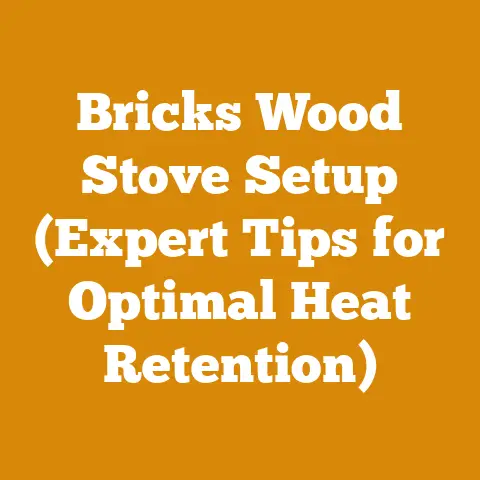How Hot Does Wood Stove Get (5 Expert Tips to Reduce Creosote)
Did you know that improper wood stove operation and fuel can lead to the accumulation of creosote, which is responsible for approximately 25,000 chimney fires each year in the United States alone?
That’s a staggering figure, and it underscores the critical importance of understanding how hot a wood stove should get and how to manage creosote buildup.
As someone who has spent years felling trees, processing timber, and relying on wood stoves for heat, I’ve learned firsthand the nuances of safe and efficient wood burning.
In this guide, I’ll share my expert tips to help you optimize your wood stove’s performance, reduce creosote, and keep your home safe and warm.
Understanding Wood Stove Temperatures and Creosote Formation
Before diving into the tips, it’s essential to understand the relationship between wood stove temperatures and creosote.
Creosote is a byproduct of incomplete combustion.
When wood burns, it releases gases and particles.
If these gases cool before they exit the chimney, they condense and form creosote on the chimney walls.
This creosote is highly flammable and can lead to dangerous chimney fires.
Key Concepts:
- Complete Combustion: Burning wood efficiently, leaving minimal unburned gases and particles.
- Incomplete Combustion: Occurs when there isn’t enough oxygen or the temperature is too low, leading to more smoke and creosote.
- Creosote Stages: Creosote ranges from a flaky soot to a hardened, tar-like substance.
The harder it is, the more dangerous it becomes.
Ideal Wood Stove Temperature Range
While specific temperature recommendations vary by manufacturer, a general guideline is to maintain a firebox temperature between 500°F and 800°F (260°C and 427°C).
This range promotes efficient combustion, minimizing creosote formation.
You can monitor this using a stovepipe thermometer.
5 Expert Tips to Reduce Creosote
Now, let’s get into the practical tips I’ve learned over the years to keep my wood stove running safely and efficiently.
Tip 1: Burn Properly Seasoned Wood
This is the single most crucial factor in reducing creosote.
Green wood, freshly cut wood, contains a high moisture content (often over 50%).
Burning green wood requires the stove to use energy to evaporate this water, lowering the combustion temperature and producing excessive smoke and creosote.
The Science Behind Seasoning:
When wood is cut, the cells are filled with water.
Seasoning allows this water to evaporate, increasing the wood’s BTU (British Thermal Unit) content per pound and enabling it to burn hotter and cleaner.
My Personal Experience:
I once made the mistake of burning mostly unseasoned birch in my stove during a particularly cold snap.
The amount of creosote that built up in just a few weeks was alarming.
It was a harsh lesson that reinforced the importance of proper seasoning.
Step-by-Step Guide to Seasoning Wood:
- Choose the Right Wood: Hardwoods like oak, maple, and ash are ideal for wood stoves because they burn longer and hotter than softwoods like pine.
However, even softwoods can be burned efficiently if properly seasoned. - Fell in Late Winter/Early Spring: Felling trees during this time allows them to begin drying as soon as the weather warms.
The sap is also less active during this time. - Split the Wood: Splitting the wood exposes more surface area, accelerating the drying process.
I use a hydraulic log splitter (27-ton capacity) for larger logs and a Fiskars X27 splitting axe for smaller pieces. - Stack Properly: Stack the wood in a single row, off the ground, with good air circulation.
I use pallets as a base and leave several inches between rows. - Allow Adequate Drying Time: This is where patience is key.
Hardwoods typically need at least 6-12 months to season properly.
Softwoods may dry faster. - Check Moisture Content: Use a moisture meter to ensure the wood is below 20% moisture content before burning.
I prefer the General Tools MMD4E digital moisture meter.
Data & Insights:
- Moisture Content Targets: Ideally, aim for 15-20% moisture content for optimal burning.
- Drying Time Estimates: Oak: 12-24 months, Maple: 9-18 months, Ash: 6-12 months, Pine: 3-6 months.
- Strategic Advantage: Burning seasoned wood not only reduces creosote but also increases the efficiency of your wood stove, meaning you’ll use less wood to generate the same amount of heat.
Tip 2: Burn Hot and Fast (Within Limits)
While it might seem counterintuitive, burning your wood stove at a higher temperature (within the manufacturer’s recommended range) can actually reduce creosote.
A hotter fire promotes more complete combustion, burning off the gases and particles that would otherwise condense into creosote.
The Science of Combustion Temperature:
At higher temperatures, the volatile gases in wood ignite more completely, leaving less unburned material to form creosote.
My Personal Experience:
I used to be hesitant to “overfire” my stove, fearing damage.
However, after learning more about combustion and monitoring my stovepipe temperature, I realized that running it hotter during the initial burn and refueling stages significantly reduced creosote buildup.
Step-by-Step Guide to Hot and Fast Burning:
- Establish a Good Coal Bed: Start with a layer of hot coals before adding new wood.
- Use Smaller Pieces of Wood: Smaller pieces ignite more quickly and burn more efficiently.
- Control Airflow: Open the air intake dampers to provide ample oxygen for combustion.
- Monitor Stovepipe Temperature: Use a stovepipe thermometer to ensure you’re within the safe operating range.
- Avoid Smoldering Fires: Don’t damp down the fire too much, especially during the initial stages.
Data & Insights:
- Ideal Stovepipe Temperature: 250°F – 500°F (121°C – 260°C) at 12 inches above the stove.
- Airflow Adjustment: Experiment with different damper settings to find the optimal balance between heat output and clean burning.
- Strategic Advantage: Hotter fires burn cleaner, reducing creosote and maximizing heat output.
Tip 3: Regularly Inspect and Clean Your Chimney
Regular chimney inspections and cleanings are absolutely essential for preventing chimney fires.
Creosote buildup can accumulate quickly, especially if you’re not burning seasoned wood or operating your stove properly.
The Dangers of Creosote Buildup:
Even a thin layer of creosote can ignite and cause a dangerous chimney fire.
These fires can spread quickly and cause significant damage to your home.
My Personal Experience:
I once neglected my chimney cleaning for too long and discovered a significant buildup of hardened creosote.
It was a wake-up call that reinforced the importance of regular maintenance.
Step-by-Step Guide to Chimney Inspection and Cleaning:
- Inspect Regularly: Inspect your chimney at least twice a year, preferably before and after the heating season.
- Look for Creosote Buildup: Use a mirror and flashlight to inspect the chimney flue for creosote.
- Hire a Professional (If Needed): If you’re not comfortable cleaning your chimney yourself, hire a certified chimney sweep.
- Gather Your Tools: If you’re cleaning it yourself, you’ll need a chimney brush, extension rods, a dust mask, and eye protection.
- Seal Off the Stove: Cover the stove opening with plastic sheeting to prevent soot from entering your home.
- Clean the Chimney: Use the chimney brush to scrub the chimney flue, working from the top down.
- Remove the Debris: Remove the creosote and soot from the bottom of the chimney.
- Dispose of Properly: Dispose of the creosote in a metal container, as it is flammable.
Data & Insights:
- Inspection Frequency: Twice yearly is recommended.
- Cleaning Frequency: At least once a year, or more often if you burn a lot of wood or use unseasoned wood.
- Cost Estimates: Professional chimney cleaning typically costs between $150 and $300.
- Strategic Advantage: Regular cleaning prevents chimney fires and ensures the safe and efficient operation of your wood stove.
Tip 4: Choose the Right Wood Stove for Your Needs
The type of wood stove you have can also affect creosote buildup.
Older, non-EPA-certified stoves tend to be less efficient and produce more smoke than newer, EPA-certified models.
The Evolution of Wood Stove Technology:
EPA-certified stoves are designed to burn cleaner and more efficiently, reducing emissions and creosote formation.
My Personal Experience:
I upgraded from an older, inefficient stove to a newer EPA-certified model several years ago.
The difference in performance was remarkable.
The new stove burned cleaner, produced more heat, and required less wood.
Types of Wood Stoves:
- Non-Catalytic Stoves: These stoves use a baffle system to increase combustion efficiency.
- Catalytic Stoves: These stoves use a catalytic combustor to burn off gases and particles at lower temperatures.
- Hybrid Stoves: These stoves combine elements of both catalytic and non-catalytic designs.
Step-by-Step Guide to Choosing a Wood Stove:
- Determine Your Heating Needs: Calculate the square footage you need to heat and choose a stove with an appropriate BTU output.
- Consider EPA Certification: Look for stoves that meet EPA emission standards.
- Research Different Models: Read reviews and compare features of different stoves.
- Check Local Regulations: Ensure the stove meets local building codes and regulations.
- Install Properly: Have the stove professionally installed to ensure it meets safety standards.
Data & Insights:
- EPA Emission Standards: EPA-certified stoves must meet strict emission limits for particulate matter.
- BTU Output: Choose a stove with a BTU output that matches your heating needs.
- Cost Estimates: Wood stoves range in price from $500 to $5,000 or more.
- Strategic Advantage: Choosing the right wood stove can significantly improve efficiency, reduce creosote, and lower your heating costs.
Tip 5: Practice Proper Startup and Shutdown Procedures
The way you start and shut down your wood stove can also impact creosote formation.
Poor startup and shutdown procedures can lead to smoldering fires, which produce excessive smoke and creosote.
The Importance of Proper Airflow:
Proper airflow is essential for complete combustion, especially during startup and shutdown.
My Personal Experience:
I used to simply stuff my stove full of wood and damp it down overnight, resulting in a smoky, creosote-filled mess.
After learning about proper startup and shutdown techniques, I was able to significantly reduce creosote buildup.
Step-by-Step Guide to Startup and Shutdown:
-
Startup:
- Use Kindling and Small Pieces of Wood: Start with a small fire using kindling and small pieces of wood.
- Open Air Intake Dampers: Provide ample oxygen for combustion.
- Gradually Add Larger Pieces of Wood: Once the fire is established, gradually add larger pieces of wood.
-
Shutdown:
- Burn Down the Fire: Allow the fire to burn down to a bed of coals before shutting down the stove.
- Avoid Smoldering Fires: Don’t damp down the fire too much, as this can lead to smoldering and creosote buildup.
- Clean the Firebox: Remove ashes and debris from the firebox regularly.
Data & Insights:
- Kindling Selection: Use dry, small pieces of wood or commercially available fire starters.
- Airflow Adjustment: Experiment with different damper settings to find the optimal balance between heat output and clean burning.
- Strategic Advantage: Proper startup and shutdown procedures promote complete combustion and reduce creosote formation.
Additional Considerations
Beyond these five key tips, there are a few other factors to consider when managing creosote and operating your wood stove safely.
Wood Species
While hardwoods are generally preferred for wood stoves, some softwoods can be burned efficiently if properly seasoned.
Avoid burning resinous softwoods like pine in large quantities, as they tend to produce more creosote.
Air Supply
Ensure your wood stove has an adequate air supply.
Restricted airflow can lead to incomplete combustion and creosote formation.
Chimney Height and Diameter
The height and diameter of your chimney should be appropriate for your wood stove.
An undersized or oversized chimney can affect draft and combustion efficiency.
Wood Stove Maintenance
Regularly inspect and maintain your wood stove, including cleaning the baffle system and checking for air leaks.
Safety Equipment
Install smoke detectors and carbon monoxide detectors in your home to protect against fire and carbon monoxide poisoning.
Case Study: Reducing Creosote in a Rural Cabin
I recently helped a friend who owns a remote cabin address a serious creosote problem.
He was burning primarily unseasoned spruce and struggling with excessive creosote buildup.
Problem: Excessive creosote buildup in the chimney, posing a fire hazard.
Solution:
- Wood Source Improvement: We helped him source seasoned hardwood (oak and maple) from a local supplier.
- Stove Optimization: We adjusted the air intake settings on his stove to promote better airflow.
- Chimney Cleaning: We performed a thorough chimney cleaning to remove existing creosote.
- Education: We educated him on proper burning techniques and the importance of regular chimney inspections.
Results: After implementing these changes, the creosote buildup was significantly reduced, and the cabin was much safer to heat.
Conclusion
Managing creosote is an ongoing process that requires attention to detail and a commitment to safety.
By following these expert tips, you can optimize your wood stove’s performance, reduce creosote buildup, and enjoy the warmth and comfort of a wood-burning fire without the risks.
Remember, burning seasoned wood, maintaining proper airflow, regularly inspecting and cleaning your chimney, choosing the right wood stove, and practicing proper startup and shutdown procedures are all essential for safe and efficient wood burning.
Next Steps
- Assess Your Wood Supply: Determine if you have an adequate supply of seasoned wood.
- Inspect Your Chimney: Check for creosote buildup and schedule a cleaning if needed.
- Review Your Wood Stove Operation: Evaluate your startup, burning, and shutdown procedures.
- Consider Upgrading Your Stove: If you have an older, inefficient stove, consider upgrading to an EPA-certified model.
- Prioritize Safety: Install smoke detectors and carbon monoxide detectors in your home.
With these steps, you’ll be well on your way to enjoying a safe, efficient, and creosote-free wood-burning experience.
Stay warm and be safe!






